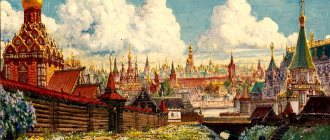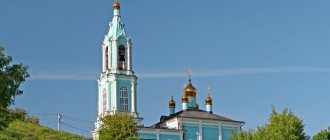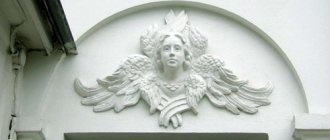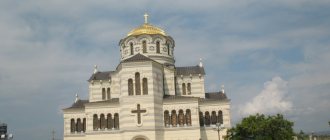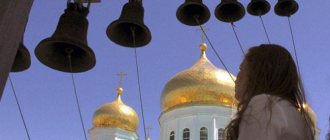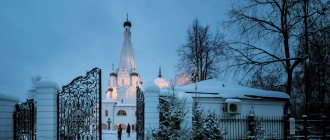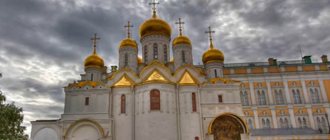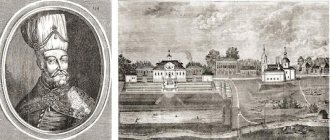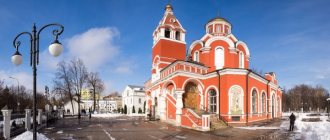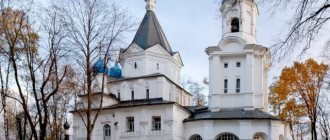Mir
Russia Moscow Cathedral of the Assumption of the Blessed Virgin Mary on Krutitsy (Moscow) Map is loading…
{"format":"leaflet","minzoom":false,"maxzoom":false,"limit":50,"offset":0,"link":"all","sort":[""], "order":[],"headers":"show","mainlabel":"","intro":"","outro":"","searchlabel":"\u2026 \u0441\u043b\u0435\ u0434\u0443\u044e\u0449\u0438\u0435 \u0440\u0435\u0437\u0443\u043b\u044c\u0442\u0430\u0442\u044b","default":"","import-annotation":false,"width ":"auto","height":"350px","centre":{"text":"","title":"""link":"""lat":55.72754459277999927735436358489096164703369140625,"lon": 37.65891743417000014915174688212573528289794921875,"icon":""},"title":"","label":"","icon":"","lines":[],"polygons":[],"circles":[ ],"rectangles":[],"copycoords":false,"static":false,"zoom":8,"defzoom":14,"layers":["OpenStreetMap"],"image layers":[] ,"overlays":[],"resizable":false,"fullscreen":true,"scrollwheelzoom":true,"cluster":false,"clustermaxzoom":9,"clusterzoomonclick":true,"clustermaxradius":80, "clusterspiderfy":true,"geojson":"","clicktarget":"","showtitle":true,"hidenamespace":false,"template":"","userparam":"","activeicon": "","pagelabel":false,"ajaxcoordproperty":"","ajaxquery":"","locations":[{"text":"\u003Cb\u003E\u003Ca href=\"/palomnik/%D0% A1%D0%BE%D0%B1%D0%BE%D1%80_%D0%A3%D1%81%D0%BF%D0%B5%D0%BD%D0%B8%D1%8F_%D0%9F% D1%80%D0%B5%D1%81%D0%B2%D1%8F%D1%82%D0%BE%D0%B9_%D0%91%D0%BE%D0%B3%D0%BE%D1% 80%D0%BE%D0%B4%D0%B8%D1%86%D1%8B_%D0%BD%D0%B0_%D0%9A%D1%80%D1%83%D1%82%D0%B8% D1%86%D0%B0%D1%85_(%D0%9C%D0%BE%D1%81%D0%BA%D0%B2%D0%B0)\» title=\»\u0421\u043e\u0431\ u043e\u0440 \u0423\u0441\u043f\u0435\u043d\u0438\u044f \u041f\u0440\u0435\u0441\u0432\u044f\u0442\u043e\u0439 \u0411\u043e\u 0433\u043e\u0440\u043e\u0434\ u0438\u0446\u044b \u043d\u0430 \u041a\u0440\u0443\u0442\u0438\u0446\u0430\u0445 (\u041c\u043e\u0441\u043a\u0432\u0430)\u003 E\u0421\u043e\u0431\ u043e\u0440 \u0423\u0441\u043f\u0435\u043d\u0438\u044f \u041f\u0440\u0435\u0441\u0432\u044f\u0442\u043e\u0439 \u0411\u043e\u 0433\u043e\u0440\u043e\u0434\ u0438\u0446\u044b \u043d\u0430 \u041a\u0440\u0443\u0442\u0438\u0446\u0430\u0445 (\u041c\u043e\u0441\u043a\u0432\u0430)\u003C/ a\u003E\u003C/b\ u003E\u003Chr /\u003E\u003Ca href=\»/palomnik/%D0%A1%D0%B2%D0%BE%D0%B9%D1%81%D1%82%D0%B2%D0%BE:%D0 %90%D0%BD%D0%BD%D0%BE%D1%82%D0%B0%D1%86%D0%B8%D1%8F\" title=\"\u0421\u0432\u043e\u0439\u0441 \u0442\u0432\u043e:\u0410\u043d\u043d\u043e\u0442\u0430\u0446\u0438\u044f\»\u003E\u0410\u043d\u043d\u043e\u0442\u0430\u0446 \u0438\u044f\u003C/ a\u003E: \u043f\u0440\u0430\u0432\u043e\u0441\u043b\u0430\u0432\u043d\u044b\u0439 \u0445\u0440\u0430\u043c \u0432 \u0422\u04 30\u0433\u0430\u043d\u0441 \u043a\u043e\u043c \u0440\u0430\u0439\u043e\u043d\u0435 \u041c\u043e\u0441\u043a\u0432\u044b, \u043d\u0430 \u0442\u0435\u04 40\u0440\u0438\u0442\u043e\ u0440\u0438\u0438 \u041a\u0440\u0443\u0442\u0438\u0446\u043a\u043e\u0433\u043e \u043f\u043e\u0434\u0432\u043e\u0440\u044c\u0 44f. \u0418\u0441\u0442\u043e\u0440\u0438\u0447\u0435\u0441\u043a\u043e\u0435\u043d\u0430\u0437\u0432\u0430\u043d\u0438\u0435\ u0441\u043e\u0431\u043e\u0440 \u0430 - \u041c\u0430\u043b\u044b\u0439 \u0423\u0441\u043f\u0435\u043d\u0441\u043a\u0438\u0439 \u0441\u043e\u0431\u043e\u044 0\u0433. \u041c\u043e\u0441\u043a\u0432\u044b. \u0421\u043e\u043e\u0440\u0443\u0436\u0435\u043d \u0432 1680-1690 \u0433\u0433. \u041e\u0442\u043d\u043e\u0441\u0438\u0442\u0441\u044f \u043a \u041f\u043e\u043a\u0440\u043e\u0432\u0441\u043a\u043e\u043c\ u0443\u0431\u043b\u0430\u0433 \u043e\u0447\u0438\u043d\u0438\u044e \u041c\u043e\u0441\u043a\u043e\u0432\u0441\u043a\u043e\u0439 \u0433\u043e\u0440\u043e\ u0434\u0441\u043a\u043e\u0439 \u0435\u043f\u0430\u0440\u0445\u0438\u0438.","title":"\u0421\u043e\u0431\u043e\u0440 \u0423\u0441\u043f\u0435\u043d\u0438\u044f \u041f\u0440 \u0435\u0441\u0432\u044f\u0442\u043e\u0439 \u0411\u043e\u0433\u043e\u0440\u043e\u0434\u0438\u0446\u044b \u043d\u0430 \u041a \u0440\u0443\u0442\u0438\u0446 \u0430\u0445 (\u041c\u043e\u0441\u043a\u0432\u0430)","link":"","lat":55.72754459277999927735436358489096164703369140625,"lon":37.6589 1743417000014915174688212573528289794921875,"icon":""}],"imageLayers ":[]}
55.74001; 37.666971
Russia, Moscow, Central Administrative District, Tagansky district
Moscow
Russia
Temple phone
: +7 (495) 676-97-24
Courtyard administration phone number
: +7 (495) 676-30-93
Email:
Cathedral of the Assumption of the Blessed Virgin Mary on Krutitsy
(Small Assumption Cathedral, Mother of God Church; Assumption Church) is an Orthodox church in the Tagansky district of Moscow, on the territory of the Krutitsky courtyard. The historical name of the cathedral is the Small Assumption Cathedral of Moscow. Built in 1680-1690. Belongs to the Intercession Deanery of the Moscow City Diocese.
The Krutitsy Metochion is a historical monument founded in the 13th century, first as a monastery, and then as the residence of the bishops of Sarsk and Podonsk; former branch of the State Historical Museum. An architectural monument of the 17th century. Located in the Tagansky district of Moscow at the intersection of Krutitskaya Street and 1st Krutitsky Lane. The name of the farmstead comes from the word “Krutitsy”, which in ancient times denoted the hills on the left bank of the Moscow River below the mouth of the Yauza.
Since 1991 - the courtyard of the Patriarch of Moscow and All Rus', where the Department for Youth Affairs of the Russian Orthodox Church has been located since 2001.
History[edit]
When Bishop Vassian of Sarai arrived in the Krutitsy monastery in 1454, a stone church in the name of the holy apostles Peter and Paul already existed in Krutitsy. In 1516, this temple was rebuilt and re-consecrated in the name of the Dormition of the Mother of God, which, in contrast to the Assumption Cathedral in the Kremlin, received the name Krutitsky Small Assumption Cathedral. In 1612, when the Kremlin cathedrals were captured by the Poles, the Small Assumption Cathedral was actually the cathedral church of Moscow Orthodoxy.
Cathedral of the Assumption of the Blessed Virgin Mary on Krutitsy, 1882. (photo by Nikolai Naydenov)
Under Metropolitan Paul III, the Metropolitan Chambers were erected - the palace of the Krutitsa metropolitans. The basement of the former Assumption Cathedral, adjacent to the Metropolitan Chamber, was turned into the ceremonial Cross Chamber (metropolitan's reception room) in 1672-1675, while the St. Nicholas chapel became the home church of the Krutitsa hierarchs.
In 1665, construction began on a new stone building of the cathedral church with two altars: Peter and Paul (lower, winter) and upper - in honor of the Dormition of the Virgin Mary. Construction ended in 1689, the cathedral was consecrated in 1699, and the main Assumption throne (upper summer church) was completed only in 1700.
In 1895, a chapel was added in the name of Sergius of Radonezh.
In 1920, the temple was closed and the metropolitan tomb was destroyed. The building was rebuilt into dormitory living quarters, and the wall paintings were painted over.
From 1960 to 1980, the cathedral was used as a production facility for the All-Russian Society for the Protection of Historical and Cultural Monuments, and since 1990 - as a branch of the Krutitskoye Metochion Historical Museum.
In 1993, services were resumed in the lower church.
In 2003–2004 The domes of the Assumption Cathedral were covered with copper, and new gilded crosses were installed on them. At the same time, the civil structures of the courtyard were renewed - houses No. 11 and 13 on Krutitskaya Street. On September 21, 2004, the main shrine of the Krutitsa courtyard was transferred to the Church - the upper temple of the Assumption Cathedral with the chapel of St. Sergius of Radonezh. Currently, work is underway in the Assumption Cathedral to clear and partially restore the paintings; the roof of the Resurrection Church and the bridge courtyards are to be repaired. In 2004, the Church also received the Front Tower and the Transitional Gallery.
Every year, for more than 15 years, on the day of the Great Martyr George the Victorious, scout parades are held at the Krutitsky courtyard; Since 2002, during the days of the city of Moscow, the festival of Orthodox youth and students “The Found Generation” has been held annually. At the Krutitsky courtyard there are editorial offices of periodicals of the Youth Department: the magazine “Sretenie”, addressed to leaders working with children and youth; The Bulletin of the Department for Youth Affairs of the Moscow Patriarchate, containing information about the implementation of the Orthodox youth ministry of the Russian Church, and the children's magazine “Sledopyt”.
See also:
Historical description of the ancient Vladychny monastery on Krutitsy (1893, 95 pages)
Assumption Church in Soviet times
The October Revolution destroyed the usual way of life of the monastery, its ministers and parishioners. 1919 marked the beginning of the eviction of clergy from the monastery.
In the 1920s, the authorities openly set out to close the Assumption Church at any cost. Mass arrests of brethren and parishioners began, which continued until 1932. The Assumption Church of the metochion was deprived of its high stauropegial status, but services continued here until the end of 1933.
In 1934, a decision was made to liquidate the temple and further organize a sports hall on its territory. The church doors were closed to parishioners for many years. Almost everything was taken out of it, from icons and iconostasis to chandeliers and other church utensils. Only the crosses continued to cover the orphaned church, until they were cut down just before the war. The revered icon of the Dormition of the Mother of God, the “image and measure” of the ancient Lavra image, was transferred from the ruined courtyard to the Prince Vladimir Cathedral.
At first, the church premises were converted into a warehouse for the Leningrad military port. The Metropolitan's chambers were divided, converted into a dormitory, and then into communal apartments. During the Great Patriotic War, the temple dome hid an air defense observation post, and a bomb shelter was installed in the church basement.
In 1956, construction of an ice skating rink with artificial turf began in the main church building. Already in 1961, most sports societies in Leningrad began training on its ice.
The existence of a skating rink in the church caused enormous damage to the building: the altar housed the engine room for refrigeration units and wardrobes, and buffets and storerooms for sports and technical equipment were organized in the choir. The entire central part of the former church was occupied by a vast ice field, and the auditorium was full of portraits of Lenin and other Soviet party leaders; Patriotic banners were displayed on the walls. All these “innovations” practically destroyed the expensive Metlakh tiles on the floors and paintings on the walls and ceiling.
The ice generated cold and dampness, from which the walls deteriorated, crumbled and were destroyed by fungus. Over time, maintaining a skating rink here simply became unprofitable. However, even after the closure of the ice arena, baths functioned for some time in the Assumption Church, and later plantations were set up to grow flowers for sale, which continued to maintain humidity in the building at unacceptable levels.
Current state[edit]
Interior decoration
Description[edit]
The old, one-story church was one-domed, four-pillar, with a basement (ground floor), with cross vaults, a vestibule, a three-part apse and an upper aisle in the name of St. Nicholas.
The new cathedral received a 4-slope roof, ending with a tier of decorative kokoshniks and a traditional five-domed structure. The ensemble of the cathedral also includes a bell tower with a hipped roof, a western porch with two hipped porches and side galleries, extended to the Metropolitan Palace in 1694.
The lower tier with the warm Church of the Apostles Peter and Paul was built in 1667–1689 and consecrated on June 29, 1699. However, according to some information, the consecration was performed by Patriarch Joachim. Construction work was carried out under Metropolitan Barsanuphius, who was buried in the southern part of the lower church. The chapel of St. Sergius of Radonezh was built in 1895.
On the right side of the entrance to the Peter and Paul Lower Church of the Cathedral, a six-span hipped bell tower adjoins the temple. Even at the end of the 19th century, there were powerful bells here, one of which, a small one, was cast in 1730.
The height of the cathedral is 29 meters (up to the apple of the cross). Everything, even the onion domes, is made of red brick.
Activities[edit]
There is a children's Sunday school at the church.
The Bogudonia Charitable Brotherhood operates to care for disabled children (including childhood disabilities and wheelchair users).
Monthly charity meetings are held, and a permanent confessor is assigned.
Moscow diocese
Pilipenko A.D. – senior researcher at SIHM
Moscow region, Serpukhov, st. Volodarskogo, 2a
In the suburb, which is adjacent to the Serpukhov Kremlin, but located upstream of the river. Nary, there is a picturesque group of churches. Closer to the river and the ramparts, on a stone-lined hill, stands the Church of the Assumption of the Blessed Virgin Mary. The wooden Church of the Assumption on this site was first mentioned in 1620 in the Watch Books of the Patriarchal Treasury Order. These are materials from the census conducted by Ivan Vasilyev, son of Vsevolodsky, with the participation of the Serpukhov spiritual authorities, and, in particular, the “tenth Assumption priest Nikifor.” At that time, there were only 10 households in the Assumption parish. According to data from 1653, the parish consisted of 21 households, and in 1703 - 15 households and rented out two shops on church land adjacent to the city market (this income was used to purchase liturgical wine, incense and wax) (1). There is information that at the end of the 17th century. At the Assumption Church there was already a chapel in the name of St. Apostle John the Theologian (2).
On April 26, 1737, the priest of the Serpukhov Church of the Assumption, Fr. Vasily Evtikhiev (3) “with the parish people” appeal to the Synodal Treasury with a request to move the old wooden church and build a new, stone one in its place. On May 2 of the same year, their request was granted (4), and by 1744, “through the diligence of the parishioners,” a stone Assumption Church with a warm St. John the Theologian chapel was built (5). From 1804 to 1869, the Church of the Transfiguration, which stood across the road from it, was assigned to the Church of the Assumption (6). In 1817, a fire broke out in the Assumption Church due to a “thunderclap,” damaging its roof.
In 1854, at the expense of the hereditary honorary citizen Nikolai Maksimovich Konshin (1798-1853), the modern building of the Assumption Church was built (7). The estimate for its construction on March 3, 1845 was signed by the architect Tamansky, who, apparently, is the author (8). Most likely, this is Ivan Trofimovich Tamansky (1775-1850), involved in the construction of the Church of St. Nicholas the Bely in Serpukhov (1833-1857), a student of M. F. Kazakov and a restorer of the Moscow Kremlin. The style of I. T. Tamansky was characterized by a combination of classicism with Gothic and Old Russian motifs.
From now on, the church has three chapels: the icon of the Mother of God “Joy of All Who Sorrow”, St. Apostle and Evangelist John the Theologian and in the bell tower - St. Nicholas the Svyatosha (possibly the namesake saint of the temple builder). The Church of the Assumption is an early example of Russian architectural historicism of the 2nd half. XIX century The strict geometry of its volumes under the purely external patterned decor is a legacy of the Empire style that has not yet been eradicated. White stone carvings and stucco on the facades reproduce the motifs of Russian iconostases of the late 17th century. Inside the temple, paintings in an academic style are preserved.
Konshins are the largest industrialists of Serpukhov, 2nd half. XIX - early XX century, for several generations they were elders of the Assumption Church and provided it with considerable assistance - in particular, they annually contributed money “to maintain the deacon’s position” at the church (9). In 1917, the Assumption parish consisted of 316 residents and 357 residents of the city of Serpukhov in 69 yards (10).
It is known that from 1910 to 1915, the Kharkov province Cossack Chmel Kirill Kharitonovich (1879-1937) was a psalm-reader in the Assumption Church. Subsequently, having graduated from the Theological Seminary and becoming a priest, Father Kirill served in the Church of Joachim and Anna in Mozhaisk. Arrested on November 14, 1937 and executed at the Butovo training ground on December 2, 1937.
One of the last rectors of the Assumption Church was Archpriest Sergiy Petrovich Klyucharev (1871-1923) - a hereditary priest, the son of Archpriest Peter Klyucharev. In 1915, priest Sergius became rector of the Holy Cross Church, then, in the 1920s. — Uspensky, also served in the Kazan Church of Serpukhov. Before the revolution, he was a member of the Diocesan School Council. For active and successful teaching, he was awarded a commemorative medal for the 25th anniversary of the Central School of Education. He is married to the sister of the Serpukhov priest Ivan Vladimirovich Dobrokhotov. Father Sergius himself did not live to see the repressions, dying in 1923 from dysentery, but his family was persecuted. The youngest daughter Ekaterina, unable to withstand the bullying at school, when she was forced to take off her cross and renounce her father, lost her mind. The husband of Anna Sergeevna's eldest daughter, Karl Petrovich Poret (Latvian by nationality), was arrested and shot in Butovo on March 23, 1938.
For some time, the widow of Archpriest Alexy Petrovich Bogolepova, Maria Pavlovna Bogolepova (b. 1845), daughter of priest Pavel Vladychensky, was the prosphora bearer of the Assumption Church. The children of the Bogolepovs left a noticeable mark on the church history of Serpukhov. Two sons became priests: Alexander (b. 1868) served in the All Saints Church, Nikolai (b. 1869) - in the Spassky Church at the Zanarsky cemetery. One of the daughters of Maria Pavlovna and Father Alexy, Elena Alekseevna, became the wife of the priest of the Church of the Savior Not Made by Hands of the Vladychny Monastery, Jacob Ivanovich Brilliantov, canonized as the Holy New Martyrs and Confessors of Russia. Another of their daughters, Olga Alekseevna Bogolepova, became a highly qualified paramedic, worked in the surgical department of the Serpukhov hospital at the Red Textile Worker, and was an assistant in the operations of the famous surgeon Yudin. For reading the Psalter in the temple, according to a denunciation, she was sentenced to exile to Karaganda to the copper mines. In exile she worked as a paramedic. After rehabilitation, she refused to return to Serpukhov, declaring: “I will not abandon my miners!”
The Church of the Assumption was closed in the 1930s. Since 1999, the temple has been returned to the Russian Orthodox Church. In the process of restoring the interior of the temple, the old original frescoes, which had fallen into unsatisfactory condition during the long period of use of the temple as a warehouse, were restored. Not only was it necessary to clear and strengthen the original paint layer, but also to restore quite large fragments that had been completely lost. At the same time, it was very important to maintain the stylistic unity of the manner of Russian academic painting of the late 19th century. Vladimir Artemyev, who performed this work, according to the unanimous opinion of experts, coped with this task brilliantly. In addition, in the above-altar part of the temple, where the iconostasis, now lost, was previously located, he painted a large multi-figure composition “The Protection of the Most Holy Theotokos” with the upcoming saints. In terms of composition and manner of execution, it also organically fit into the picturesque decoration of the temple.
Here you can see the altar of the Assumption Church.
Patronal holidays:
Dormition of the Blessed Virgin Mary - August 28.
Icons of the Most Holy Theotokos “Joy of All Who Sorrow” - November 6.
St. ap. John the Theologian - May 21, October 9.
St. Nikola Svyatoshi - October 11 and 27.
Notes:
1. Kholmogorov V. and G. Historical materials about churches and villages of the XVI-XVIII centuries. Issue nine. Volokolamsk and Serpukhov tithes (Moscow province). M., 1896. pp. 96-97. 2. In the act of that time, kept in the 19th century. In the sacristy of the Vladychny Monastery, the Serpukhov gunner Bogdan Matveev, son of Avtsyn, shows that he owns a trading place “on the sovereign’s quitrent land, and not on the church’s Theological and Assumption land.” Then Avtsyn reports that he “heard by ear” that there was once a “Church of Ivan the Theologian” in the same place. There is no other news about such a temple in Serpukhov yet. – Simson P. F. Simson. The history of Serpukhov in connection with the Serpukhov Principality and in general with Russian history. M., 1880. P. 208. 3. As far as we know about him, he is a man of complex fate. On September 29, 1731, at the request of his wife, Vasily Evtikhiev was released “from the Vladychnya Monastery from under the authorities” - where he was held on charges of “becoming a false priest” to the Church of the Assumption: V. and G. Kholmogorovs. Historical materials about churches and villages of the XVI-XVIII centuries. Issue nine. Volokolamsk and Serpukhov tithes (Moscow province). M., 1896. P. 97. However, in 1747-1748, while remaining an Assumption priest, he was the head of the Serpukhov spiritual board: TsGAM / until 1917, F. 737. Op. 1. D. 9. L. 2-2v.; D. 10. L. 3; D. 12. L. 2a-rev.
4. Kholmogorov V. and G. Historical materials about churches and villages of the XVI-XVIII centuries. Issue nine. Volokolamsk and Serpukhov tithes (Moscow province). M., 1896. pp. 97-98. 5. TsGAM / before 1917. F. 737. Op. 1. D. 1079. L. 34. 6. Ibid., F. 454. Op. 3. D. 83. P. 67. 7. Ibid. F. 203. Op. 426. D. 3. 8. Ibid., L. 30. 9. Ibid. F. 737. Op. 1. D. 4086. L. 199. 10. Ibid. F. 203. Op. 426. D. 3. L. 36v;. Ibid. F. 737. Op. 1. D. 4086. L. 207.
1
Patronal holidays[edit]
Dormition of the Blessed Virgin Mary
- August 28
Peter and Paul, chief apostles
- July, 12
Sergius of Radonezh, Venerable
— Cathedral of Moscow Saints, July 18, October 8
Renovation of the Church of the Resurrection of Christ in Jerusalem (Resurrection of the Word)
— September 26
Story
The Cathedral of the Assumption of the Blessed Virgin Mary was built and consecrated in 1873 . After which it had the status of a cathedral for 43 years and for part of this time it was the residence of the head of the Catholic Church in Russia . The Cathedral's parish grew very quickly, so it was enlarged and reconsecrated in 1897 .
Before the revolution, the Cathedral was regularly visited by about twenty thousand citizens. After 1917, the authorities made many attempts to stop the work of the Cathedral , which were successful by 1930 .
During the Second World War, the temple building was heavily damaged by bombs, and after that it was given over to the needs of the city . It was only in 1995 that the work of the Cathedral was restored, when its building was returned to the church .
The temple was restored and consecrated for the third time in 1998
Now there is a library and a museum in the Cathedral ; anyone can visit it , regardless of religion.
Pilgrim[edit]
Schedule of services:
On Sundays and days of great holidays, the All-Night Vigil begins the day before at 17:00, the Divine Liturgy at 9:00.
On Saturdays, Matins and Divine Liturgy at 8:00.
On one of the weekdays (as scheduled) Matins and Divine Liturgy at 8:00.
During Great Lent, two Liturgies of the Presanctified Gifts are celebrated weekly (as scheduled) at 8:00.
On Thursdays at 17:00 there is an akathist before the Theodore Icon of the Mother of God.
Schedule of services for the month
Architecture
The Cathedral of the Assumption of the Blessed Virgin Mary is shaped like a Latin cross . It has a common entrance with the Catholic Seminary, closed by its building from the street.
Located in a quiet, inconspicuous place, the Cathedral borders the Polish Garden, the former estate of the poet Derzhavin.
Interestingly, the land on which the temple stands was purchased from his heirs .
Interior decoration
The cathedral from the inside looks spacious and ascetic , with white walls and vaults, a mandatory attribute of the Catholic Church.
The room has excellent acoustics . There is a magnificent organ that often attracts parishioners and fans of incomparable organ music to concerts.
Exterior decoration
If from the street side the Cathedral building is inconspicuous, then from the Polish Garden the impressive apse opens up to the eye .
From this altar ledge one can immediately appreciate the majestic size of the temple building .
Where is the Cathedral of the Assumption of the Blessed Virgin Mary located?
Address
st. 1st Krasnoarmeyskaya, building 11
Metro
Nearest station Technological Institute
How to get there
Take the metro to the Tekhnologichesky Institut-1 stop. Go to the side that is closer to the Fontanka. Walk 300 meters along 1st Krasnoarmeyskaya Street to the Seminary building, which will be on the right.
Telephone
8(812) 316-42-55; 989-49-39
Official site
uspenie.spb.ru/church
